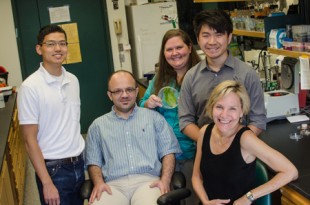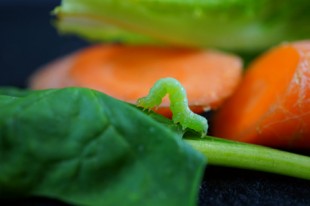MEDIA CONTACTS:
David Ruth
713-348-6327
david@rice.edu
Jade Boyd
713-348-6778
jadeboyd@rice.edu
Does your salad know what time it is?
Managing vegetables’ ‘internal clocks’ postharvest could have health benefits
HOUSTON — (June 20, 2013) — Does your salad know what time it is? It may be healthier for you if it does, according to new research from Rice University and the University of California at Davis.
“Vegetables and fruits don’t die the moment they are harvested,” said Rice biologist Janet Braam, the lead researcher on a new study this week in Current Biology. “They respond to their environment for days, and we found we could use light to coax them to make more cancer-fighting antioxidants at certain times of day.” Braam is professor and chair of Rice’s Department of Biochemistry and Cell Biology.
Braam’s team simulated day-night cycles of light and dark to control the internal clocks of fruits and vegetables, including cabbage, carrots, squash and blueberries. The research is a follow-up to her team’s award-winning 2012 study of the ways that plants use their internal circadian clocks to defend themselves from hungry insects. That study found that Arabidopsis thaliana — a widely used model organism for plant studies — begins ramping up production of insect-fighting chemicals a few hours before sunrise, the time that hungry insects begin to feed.
Braam said the idea for the new research came from a conversation with her teenage son.

Rice biologists (from left) John Liu, Wassim Chehab, Danielle Goodspeed, Zhengji "Jim" Sheng and Janet Braam showed there may be potential health benefits to storing fresh produce under day-night cycles of light.
“I was telling him about the earlier work on Arabidopsis and insect resistance, and he said, ‘Well, I know what time of day I’ll eat my vegetables!’ Braam said. “That was my ‘aha!’ moment. He was thinking to avoid eating the vegetables when they would be accumulating the anti-insect chemicals, but I knew that some of those chemicals were known to be valuable metabolites for human health, so I decided to try and find out whether vegetables cycle those compounds based on circadian rhythms.”
Arabidopsis and cabbage are related, so Braam’s team began their research by attempting to “entrain” the clocks of cabbage in the same way they had Arabidopsis. Entrainment is akin to the process that international travelers go through as they recover from jet lag. After flying to the other side of the globe, travelers often have trouble sleeping until their internal circadian clock resets itself to the day-night cycle in their new locale.
Using controlled lighting in a sealed chamber, Rice graduate student and study lead author Danielle Goodspeed found she could entrain the circadian clocks of postharvest cabbage just as she had those of Arabidopsis in the 2012 study. Following the success with cabbage, Goodspeed and co-authors John Liu and Zhengji Sheng studied spinach, lettuce, zucchini, carrots, sweet potatoes and blueberries.
“We were able to entrain each of them, even the root vegetables,” Goodspeed said. She and Braam said the findings suggest that storing fruits and vegetables in dark trucks, boxes and refrigerators may reduce their ability to keep daily rhythms.
“We cannot yet say whether all-dark or all-light conditions shorten the shelf life of fruits and vegetables,” Braam said. “What we have shown is that keeping the internal clock ticking is advantageous with respect to insect resistance and could also yield health benefits.”
In the cabbage experiments, Braam, Goodspeed and Rice co-authors John Liu, Zhengji “Jim” Sheng and Wassim Chehab found they could manipulate cabbage leaves to increase their production of anti-insect metabolites at certain times of day. One of these, an antioxidant called glucoraphanin, or 4-MSO, is a known anti-cancer compound that has been previously studied in broccoli and other vegetables.
Braam’s team has already begun follow-up research, which is supported by the Bill and Melinda Gates Foundation, into whether light and other stimuli, like touch, may be used to enhance pest resistance of food crops in developing countries.
“It’s exciting to think that we may be able to boost the health benefits of our produce simply by changing the way we store it,” Goodspeed said.
Additional co-authors include Marta Francisco and Daniel Kliebenstein, both of the University of California at Davis. The research was supported by the National Science Foundation and by a 2011 Medical Innovation Award from the Rice University Institute of Bioscience and Bioengineering.
###
VIDEOS are available at:
Does your salad know what time it is?
https://www.youtube.com/watch?v=2zzgpPpln5k
A time-lapse comparison of caterpillars eating postharvest lettuce
https://www.youtube.com/watch?v=oP-99pOM4Yg
High-resolution IMAGES are available for download at:
https://news2.rice.edu/files/2013/06/0620-VEGGIE-group2-lg.jpg
CAPTION: Rice biologists (from left) John Liu, Wassim Chehab, Danielle Goodspeed, Zhengji “Jim” Sheng and Janet Braam showed there may be potential health benefits to storing fresh produce under day-night cycles of light.
CREDIT: Jeff Fitlow/Rice University
https://news2.rice.edu/files/2013/06/0620-VEGGIE-samples-lg.jpg
CAPTION: Rice University undergraduate researcher Zhengji “Jim” Sheng prepares to place samples of lettuce and caterpillars in a chamber with controlled lighting. The notation DL refers to the dark-light circadian rhythm of the caterpillar. When the circadian clock of the lettuce matches that of the caterpillar, the leaves are less likely to be eaten.
CREDIT: Jeff Fitlow/Rice University
https://news2.rice.edu/files/2013/06/0620-VEGGIE-looper43-lg.jpg
CAPTION: A cabbage looper caterpillar with spinach and carrots.
CREDIT: Se Kim/Rice University
A copy of the Current Biology paper is available at:
http://dx.doi.org/10.1016/j.cub.2013.05.034
Braam and Chehab describe the group’s award-winning 2012 study in this podcast:
http://www.pnas.org/site/misc/CozzarelliClassVI-Podcast.mp3


